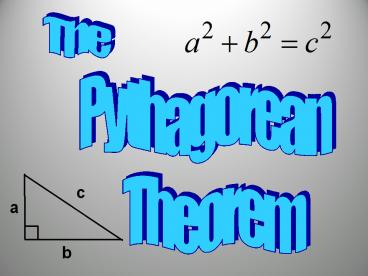The - PowerPoint PPT Presentation
1 / 33
Title:
The
Description:
c a b This is a right triangle: We call it a right triangle because it contains a right angle. The measure of a right angle is 90o 90o The little square 90o ... – PowerPoint PPT presentation
Number of Views:29
Avg rating:3.0/5.0
Title: The
1
The
Pythagorean
Theorem
c
a
b
2
This is a right triangle
3
We call it a right triangle because it contains a
right angle.
4
The measure of a right angle is 90o
90o
5
in the
The little square
angle tells you it is a
right angle.
90o
6
About 2,500 years ago, a Greek mathematician
named Pythagorus discovered a special
relationship between the sides of right triangles.
7
Pythagorus realized that if you have a right
triangle,
8
and you square the lengths of the two sides that
make up the right angle,
9
and add them together,
10
you get the same number you would get by squaring
the other side.
11
Is that correct?
?
?
12
It is. And it is true for any right triangle.
13
The two sides which come together in a right
angle are called
14
The two sides which come together in a right
angle are called
15
The two sides which come together in a right
angle are called
legs.
16
The lengths of the legs are usually called a and
b.
a
b
17
The side across from the right angle
is called the
hypotenuse.
a
b
18
And the length of the hypotenuse
is usually labeled c.
c
a
b
19
The relationship Pythagorus discovered is now
called The Pythagorean Theorem
c
a
b
20
The Pythagorean Theorem says, given the right
triangle with legs a and b and hypotenuse c,
c
a
b
21
then
c
a
b
22
Find the length of a diagonal of the rectangle
?
23
Find the length of a diagonal of the rectangle
?
c
b 8
a 15
24
(No Transcript)
25
Find the length of a diagonal of the rectangle
17
26
Practice using The
Pythagorean Theorem to solve these right
triangles
27
13
28
(No Transcript)
29
24
(a)
(c)
30
9
31
Pythagorean Triples
- There are cases when the lengths of the sides of
a right-angled triangle have integral values - Whole numbers only (No Fractions)
- The 3, 4, 5 right-angled triangle is such a case
The numbers 3, 4 and 5 are said to form a
Pythagorean Triple
52 32 42
32
Pythagorean Triples
- There are an infinite number of Pythagorean
triples
- Here are two more examples
33
Summary
- Find the legs and hypotenuse.
- Square the legs (this is a and b)
- Add them together
- Square root them
- This is the length of the hypotenuse
(this is c)































